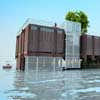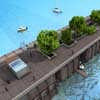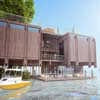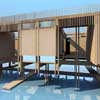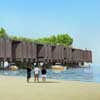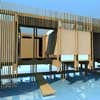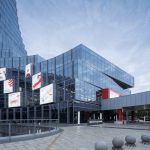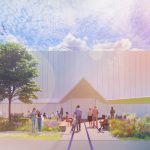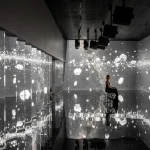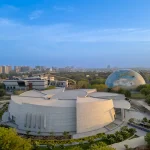Pier Migrant Mangrove Museum Miami, Lummus Park Architecture, FL picture, Architect
Pier Migrant Mangrove Museum, Miami Building
Lummus Park Design, Florida design by Paul Cremoux W. & Manuel Angel Bugallo O.
Architect designer: Paul Cremoux W. / Manuel Angel Bugallo O.
Pier Migrant Mangrove Museum Concept
March 9, 2011
Pier Migrant Mangrove Museum Miami, Florida
The architects envision The Pier-Museum not only as a commemorative space for the new urban and multicultural crossbreeding in the 21st century, but also as an ecological assistant devise.
Impoverishment of the Caribbean water quality, among other factors has caused the disparition of 50% of the Caribbean coral reef. Pollution, water increasing acidity levels and synthetic chemicals can be gradually clean out by a system of living / buildings ecosystems. So we think of the building as a environmental responsible and cultural enriching experience entity.
The Building and the City
As one walks through the Fifth Avenue and approaches to the Lummus Park, a wooden floor begins to merge, gradually transforming itself on a series of public furniture and pedestrian walks. Continuing to the sea, this structure will begin to rise and by touching the beach, a node of stairs and showers welcome the beach pedestrian visitor to climb high deck. Continuing walking and you will discover a great view: Upper deck shaded by big mangroves that emerge from the circulation patio of the building, water reflections from the sea visitor’s disembarkation lower pier, and the skyline of Miami Downtown.
Two glass / wooden box-shaped structures, one at each end of the building, stand out from the great main deck, where two staircases and elevators lead the visitor to the three-story building. At the first floor, an open, double-high reception welcomes the visitor open it self to the mangrove main patio. A framed glass-door introduces the visitor to the multiple bridges that connect each space of the building.
The project emerges from the idea of redistributing the inner area to the five allowed “cantilever” meters. So we produce an interior space full of vegetation and water known as “the floating forest”. Architecture, water and vegetation will make one whole element. At this space, the visitor will be able to enjoy the different exhibitions through out an open shaded patio circulation that will provide a unique pleasant experience.
The Floating Forest
Made up of mangroves, environmental benefits:
– Trap debris and silt that will contribute to soil formation and stabilizing the coastline.
– Act as a filtering system for the run-off and ground waters, clarifying adjacent open water, which makes photosynthesis in marine plants easier. Mangroves will also help to avoid other forms of pollution, including excess amounts of nitrogen and phosphorous, petroleum products, and halogenated compounds. Mangroves will stop these contaminants from polluting the ocean waters through a process called rhizofiltration.
– Produce nutrients.
– Protect coastal land by absorbing the energy of storm -driven wave and wind action- and create a natural breakwater that will help stop erosion, will prevent a great deal of property damage and sometimes even human death.
– Serve as a nursery and refuge for many juvenile fish and invertebrates and birds.
Building the Mangrove
According to studies carried out by the Reef Ball Mangrove Solution division of Reef Ball Foundation Inc., it is possible to restore the mangroves or to create them through the implementation of a system based on the collaboration of the reef balls in the intertidal zone. Reef Balls are made by pouring concrete into a fiberglass mold (shown) containing a central Polyform buoy surrounded by various sized inflatable balls to make holes. There are over a dozen different standard mold sizes and custom sizes are possible.
Molds obtained from the Reef Ball Foundation are generally supplied with spare parts, tool kits, starting concrete additive supplies, and training. Sometimes, additional items such as coral propagation kits are added. Usually, clients only need to supply some plywood to build the base, a source of compressed air, and a fresh water supply. Any type of concrete can generally be used, including end-of-day waste, but additives such as microsilica and a high range water reducer are needed to give the Reef Balls high strength and to make the concrete suitable for marine life growth.
Pier Migrant Mangrove Museum Miami images / information from Paul Cremoux studio
Paul Cremoux studio are a small Mexican Architectural Firm – their work has been shown at the RIBA as part of the London Festival of Architecture 2008, and also at the MAM (Museo de Arte Moderno de Mexico) México City among others.
Location: Lummus Park, Miami, Florida, USA
Miami Architecture
Contemporary Miami Architecture
Miami Architectural Designs – chronological list
Architecture Tours Miami by e-architect : exclusive guided walks
Miami Architecture Offices : Studio Listings
Miami Pier Museum of Latin American Immigrants, South Beach
Maciej Jakub Zawadzki
Miami Pier Museum
Miami Architecture – Selection
ilonabay, Miami Beach
Oppenheim Architecture + Design
Miami Beach Condo
1111 Lincoln Road, Miami Beach
Design: Herzog & de Meuron
1111 Lincoln Road Miami Beach
Montclair, South Beach, Miami Beach
Architects: Oppenheim Architecture + Design
Miami Beach apartments
Another Florida Landscape Design:
The ArtsPark at Young Circle, Hollywood
Design: Glavovic Studio, Inc
Florida Park
Comments / photos for the Pier Migrant Mangrove Museum Miami design by Paul Cremoux W. & Manuel Angel Bugallo O. page welcome.
Website: n/a
Website: Miami, Florida

